
Found in Space
Attention all space cadets! The Victorian Space Science Education Centre makes science fun.
Text:/ Mandy Jones
While most of the adult population has long since lost interest in space – unless, of course, there’s the threat of an asteroid hitting the earth and interrupting a football match or a royal wedding – it remains an area of fascination to most teenagers. To harness this interest, science educators in Victoria have created a space science education facility where secondary teachers and students can experience science curriculum in an engaging and enjoyable way. Having been established by the Victorian State Government to operate as a specialist mathematics and science centre of excellence, the Victorian Space Science Education Centre (VSSEC) has been operating since 2006.
Through the context of space, the centre provides practical and applied opportunities in various science disciplines, including chemistry, physics, biology and geology. VSSEC’s home is an impressive looking building set within the grounds of Strathmore Secondary College in Melbourne’s north west. Resembling a spiral galaxy, the building was designed by Gregory Burgess Architects to capture the imagination of the students and staff who participate in its innovative science programs.
On the day I visit VSSEC, they’re gearing up for an intensive two-week rejuvenation period while the centre is closed over the first term school holidays. I’m taken on a tour of the facility by VSSEC’s Shaun Clarke, an affable young AV and ICT (Information & Communications Technology) technician wearing a black t-shirt emblazoned with “Have you tried switching it off and on again?”. Shaun is a graduate of Strathmore Secondary College, his computer and audiovisual support to the school beginning while he was still a student. Now employed full-time, it’s apparent that Shaun’s ingenuity is a large part of the centre’s ongoing success.
“It’s a really unique place to work. Each day is totally different – one day I’m pulling cable through a wall, the next I’m fixing computers, so it never gets boring,” Shaun explains.
As a teaching facility, VSSEC is out of this world… literally. Two of the most popular programs that schools can book into are Mission to Mars and Mission to the Orbiting Space Laboratory. Both programs are aimed at Year 9 and 10 students, and require students to work collaboratively to conduct experiments and solve problems to successfully complete their mission. The audiovisual technology at VSSEC supports the program curriculum by providing content, communications, monitoring and the all-important space-themed atmosphere.
(above) A VSSEC astronaut collects a rock sample during a surface mission on Mars. Image courtesy VSSEC
MARS AIN’T NO PLACE TO TEACH A KID
In the Mission to Mars experience, the students spend time as Astronauts, Mission Controllers and Research Scientists. Their experience starts with an introductory film in the theatre where they learn about the mission and their individual roles. Half of the group becomes the mission controllers, so they report to the Mission Control room, while the astronauts head to the Mars briefing room where they get suited up into their spacesuits, backpacks and helmets, and collect the equipment they will need to conduct the experiments. The backpacks assigned to each astronaut contain a custom built low-power computer running Windows XP that provides communication to Mission Control via USB headsets. The battery pack that runs the solid-state drive also powers the fan that supplies air to the astronaut’s helmet.
Shaun explains the communications system used is TeamSpeak V2, a PC-based program most commonly used by gamers to communicate with their teammates. On start-up the computers connect to VSSEC’s Cisco wireless network, run a login script and join the communications server with the correct naming and grouping. The educator running the session can drag and drop students’ logins into different groups to talk, depending on their specific role within the mission. At Mission Control, communication is configured as push-to-talk, whereas for the astronauts it is voice activated.
“This is probably one of the more unusual applications of TeamSpeak, but it is a simple solution, and it works really well,” says Shaun.
Once they are geared up, the astronauts enter the Mars Lander, a small metal-clad chamber which simulates landing on the surface of Mars thanks to some flashing lights, alarms, mechanical noise and muffled announcements. As they push through the doors and exit the lander, the student astronauts find themselves in a Martian landscape of red dust and large red boulders. A giant inflatable canvas dome encloses the set helping to create an other-worldly atmosphere, as well as hiding the technical infrastructure beyond. The canvas beautifully diffuses light from the 11 banks of dimmable-ballast, orange-sleeved fluorescent tubes encircling the space. Under the control of an Enttec DMXStreamer, these fluoros are run through a range of pre-programmed sequences to provide effects such as dawn breaking and planetary storms.
A surveillance camera mounted on top of the lander enables Mission Control to monitor the astronauts when they first land on the surface. Once the astronauts set up a portable camera on a communications cart, they communicate with Mission Control who then switch their monitoring source to the portable camera. The mission controllers are then able to monitor and direct the astronauts as they gather their rock and soil samples.
The floor of the Martian surface is a large curved dish sitting over a grid of floorpits. In order to mimic the surface and conditions of Mars, some sections of the floor are heated to simulate lava flow. The VSSEC lab staff use dry ice to freeze another section of the floor prior to each mission so that the astronauts can take an ‘ice core’ sample in their exploration. Subwoofer ‘shakers’ are even installed under the floor so the students can take seismic readings.
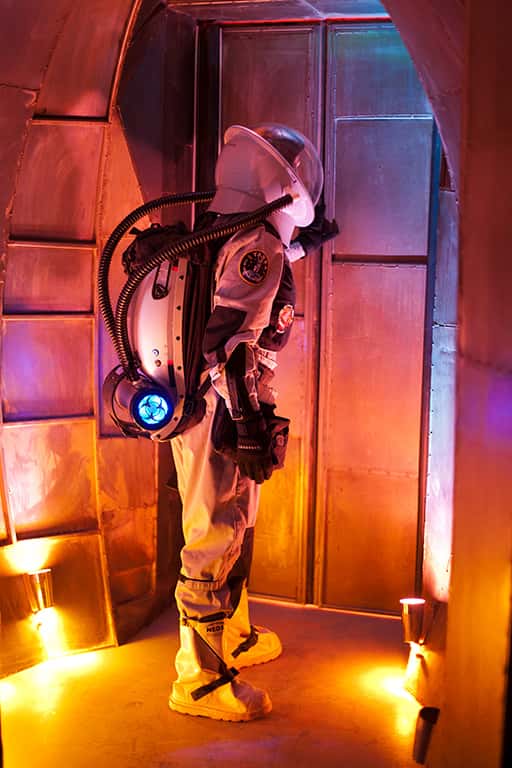
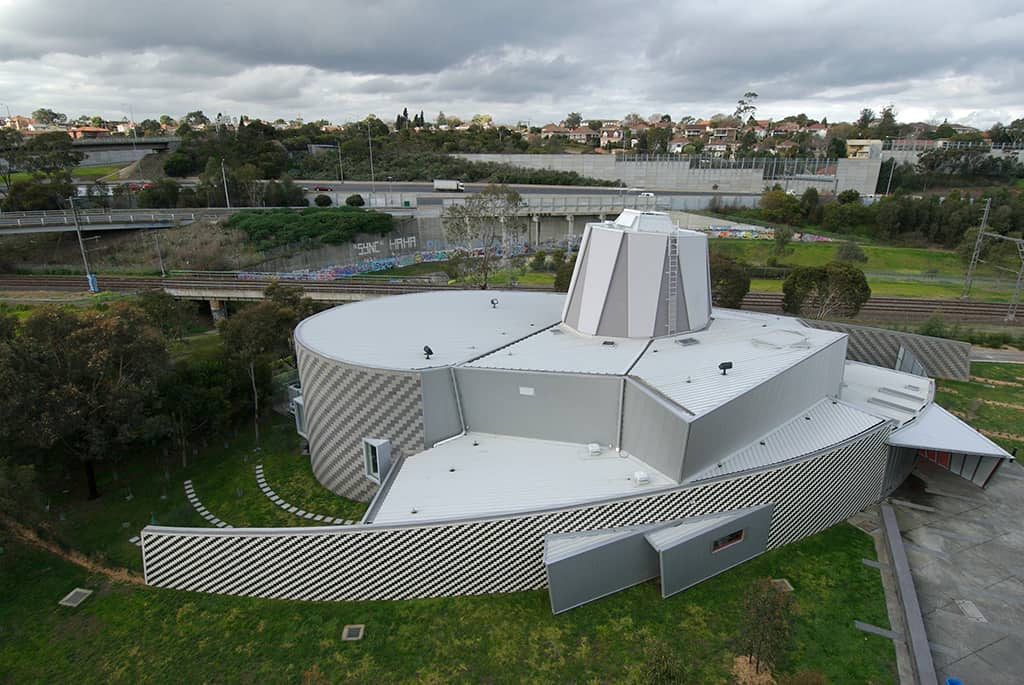
HOUSTON: WE’VE SOLVED A PROBLEM
Back at Mission Control, the controllers work their way through mathematical problem solving using custom software to track a solar storm and calculate how long before it will reach the astronauts. If they miscalculate and don’t evacuate the astronauts in time, the Mars surface plunges into darkness and a high-powered Dataflash AF1000 strobe fires up and any astronauts left on the surface are dead.
“Mission to Mars is definitely the most popular program because it’s very hands-on and quite unique. It’s definitely not something you would find in your local school,” says Shaun.
The effective lighting design for the Mars surface was done by lighting design company Bluebottle, and the installation and equipment including Dynalite dimmers for the fluoros, an LSC dimmer rack, the Dataflash strobe and eight Selecon Pacifics used for gobo break-ups, were provided by Lightmoves.
To simplify operation of the Mars experience, Shaun plans to integrate the shakers, lighting, floor heaters and dome inflation fans into the facility’s Crestron control system. This will enable them to be controlled from the Crestron TPS-6L touchpanel installed in the Mars briefing room as well as from other Crestron touchpanels throughout the centre. Three of the new Crestron TPMC-8X wireless touchpanels have been purchased to replace older model wired touchpanels in the Massimo Room, theatre and a central entry and teaching space. The older units will be re-used in other spaces within VSSEC to further expand the control network.
“”
This is probably one of the more unusual applications of TeamSpeak, but it is a simple solution, and it works really well

ROVER CONTROL
The Mars floor is also used for an outreach program Robotic Mission to Mars which takes VSSEC’s Mars Autonomous Science Laboratory program to regional, interstate and international schools by enabling them to remotely control a Mars rover in real time over the internet.
Mission Control is set up with workstations for two six-member teams – the Vikings and the Mariners – and one teacher. Each team member is linked by the TeamSpeak communications loop, and the Mission Director from each team switches content from multiple sources, including remote camera feeds, onto three large plasma screens at the front of the control room via a touchpanel. Shaun reveals the plasmas are to be replaced later in the year by Sanyo PDG-DWL2500 ultra short throw projectors to create a continuous ultra-wide screen to make it feel more like NASA Mission Control.
The 84-seat theatre used for the Mission to Mars briefings and a range of other programs is also set to undergo an audio and vision overhaul. The current 4:3 NEC projector will be upgraded to two 16:9 Projectiondesign F32 8000-lumen DLP projectors as part of an Infitec HD 3D experience supplied by Jumbo Vision. Additional centre and side positioned JBL 8340A speakers and processing will bring the theatre’s PA up to 5.1 surround sound to complement the 3D experience. A Crestron DigitalMedia Distribution Center will provide signal routing for the HD and 3D content, while the surround sound decoding will be handled with an Extron HAE 100 together with an Extron SSP 7.1, all supplied by Soundcorp.
“Soundcorp has been fantastic to us, so they’re now our preferred supplier for a wide variety of equipment. When we find good suppliers like that, we hold onto them,” Shaun noted.

BACK TO EARTH
Once the astronauts are safely back on Earth, they analyse their data and specimens in the research lab. Both the research lab and the Massimo room, which is used as a computer lab and a back-up to Mission Control, are fitted out with projectors and Promethean ActivBoard interactive whiteboards. As part of the upgrade, the Massimo room will also receive new Sanyo PDG-DWL2500 projectors and two of the ActivBoard 587 touch-sensitive whiteboards.
“We’re very dependent on technology here; we’ve got a lot of it, so we have to keep on top of it and upgrade so that we don’t fall behind,” explains Shaun.
VSSEC has made good use of Crestron throughout the facility to integrate the classroom technology with the more complex requirements of Mission Control and the Mars surface. Crestron has supported VSSEC by providing them access to the programming software and tools to enable Shaun to code new additions to the system and patch the old code to eliminate bugs.
“Being able to write the code in-house has made all the difference. If we didn’t have access to the software and tools we wouldn’t have achieved the system integration that we have, purely because of the programming costs. The system is capable of so much and I know what we want it to do. Having the ability to change things as we need has made it a much better option and that’s why we’ve spent thousands of dollars on more Crestron gear,” Shaun explains.
VSSEC is an audiovisual integration success story – a great example of simple technologies used in complex ways to create and support an innovative learning environment.
MORE INFO
Victorian Space Science Centre: www.vssec.vic.edu.au
Bluebottle: www.bluebottle.com.au
Lightmoves (Dynalite, Selecon, Enttec, LSC): www.lightmoves.com.au
Jumbo Vision (projectiondesign, Infitec): www.jumbovision.com.au
Soundcorp (Crestron, Extron, JBL): www.soundcorp.com.au
GT Innovations (Promethean, Sanyo): www.gtinnovations.com.au
Crestron: www.crestron.com.au



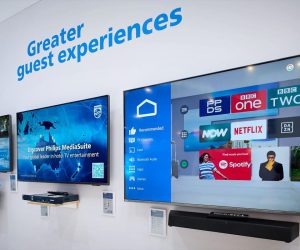




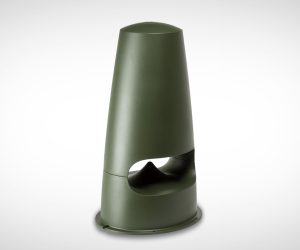
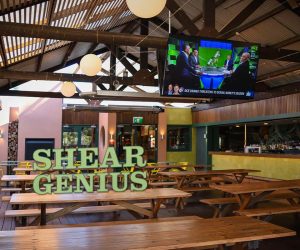





RESPONSES